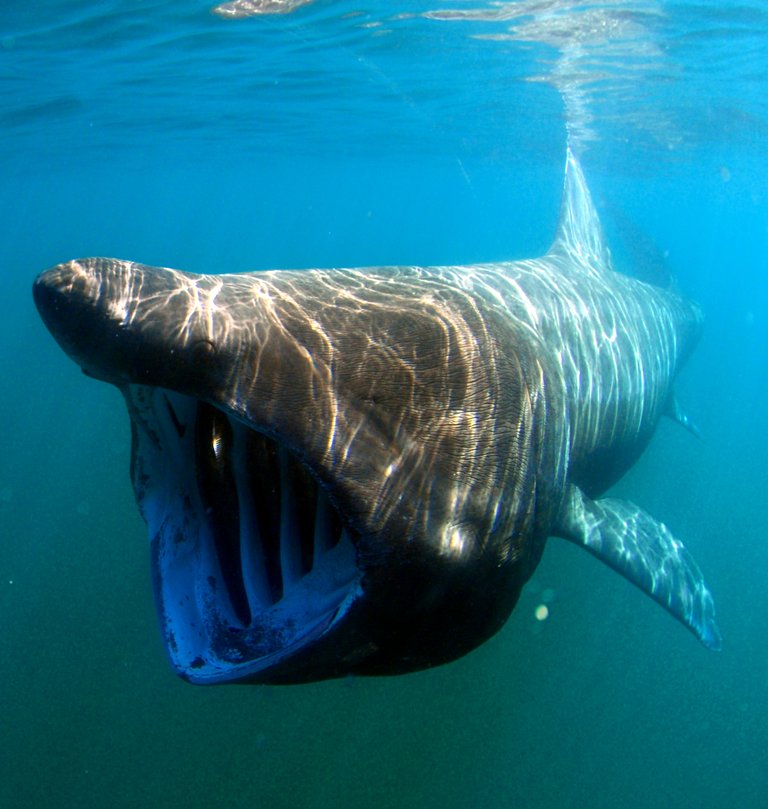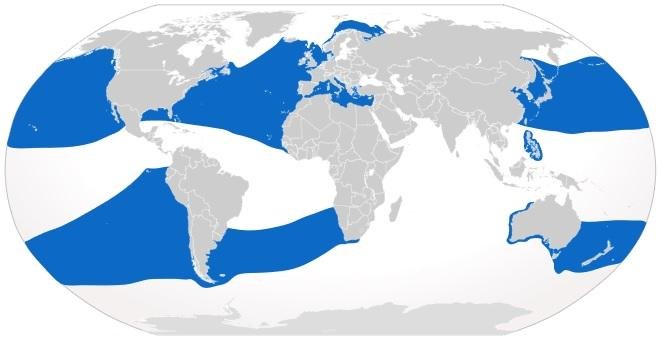One of my favorite things about animal science is that there’s still a lot of strange behavior seen in species that we haven't seen before, and have absolutely no idea why they do this thing. And that’s exactly what has happened with the basking sharks (Cetorhinus maximus) lately when research found that they go into a swarm in the autumn.

A basking shark in the process of eating. Image by Greg Skomal / NOAA Fisheries Service, posted as Public Domain.
The basking shark is the second biggest species of shark, after the whale shark (Rhincodon typus). An adult can reach up to 8 meters / 26 feet in length, but fear not, they do not attack humans. In fact, they don’t eat meat at all. The basking sharks are actually slow-moving filter feeders that mostly eat zooplankton, but can also fill up on small fish and invertebrates if they happen to end up in the mouth of the basking shark.
The sharks are found pretty much all over the ocean, with the exception of the warm waters close to the equator that it will only cross if it has to. Although it is found in most parts of the world, seeing a basking shark is rather rare, since they tend to swim either solitary or in very small groups, and spend most of their time in the depths of the ocean.

The range of the basking shark. Image by TheEmirr, posted with the Creative Commons Attribution-Share Alike 3.0 Unported license.
Like most large sharks and whales, it is threatened with extinction due to over-harvesting, and it is classified as Vulnerable by the IUCN Red List. While most nations do not harvest basking sharks these days, many populations are still struggling with recuperating from losses during the 20th century.
Shark swarming of the basking sharks
During research on the North Atlantic right whales (Eubalaena glacialis), scientists have been deploying drones in order to survey the area to count the whales left. However, during the survey they also got footage of some interesting behavior from the basking sharks.
What they saw was that these mostly solitary sharks would form huge aggregations, with up to 1,398 whales in a single aggregation. At other swarming they only found a few hundred, but this is much higher than what even the rare groups tend to have, which is less than 7 in over 99 % of the cases.
The aggregations has only been seen during the late summer or at autumn, and a total of 10 swarms has been seen since the first one was found in 1980. During the biggest recorded aggregation of 2013 with almost 1,400 sharks, there was a high abundancy of zooplankton in the area, which could be a potential clue when it comes to finding out what this swarming is all about.

Just look at how small the human is compared to the basking shark! Image is Public Domain.
And that’s pretty much all we know of the swarms! There are of course some hypotheses surrounding the swarms, and the most popular one is that they aggregate in order to reduce the drag that is caused when swimming with their huge mouths open. Just like how you can see birds fly in formations to prevent drag, some scientists believe that these sharks will swim in the same formations to save energy.
This could mean that they meet up at certain locations where there is a lot of zooplankton and feast on these while also conserving energy by reducing drag. Maybe it even is an important annual event each autumn that is critical for them to have if they want to survive the winter?
It’s a shame that scientists mostly have aerial photos to work on, because there are surely lots of more clues if they were able to get closer and witness their behavior underwater. But since they have found 10 aggregations in the last 40 years, there is a of course always a chance they they could be more lucky the next time and spot it before it is too late to get samples. It would certainly be interesting to learn more about the mysterious behavior.
Join in on the research if you see a basking shark!
I love citizen science, and there happen to be a pretty cool citizen science project with the basking sharks. The project called “Spot a Basking Shark” is led by National Marine Fisheries Service (NMFS), and wants to know where and how many basking sharks you have seen.
So if you see one, just head over to their website and fill out the form, and your sight could actually help scientists understand the behaviors of the basking shark!
Thanks for reading
I think it's pretty cool when scientists find strange behaviors such as swarming in a mostly solitary species, and it certainly goes to show how little we know about some animals. The ocean is still mostly unstudied, with thousands or even millions of small secrets that are waiting to be uncovered.
Hopefully this small little discovery about the aggregation of basking sharks can lead to a better understanding of this amazing shark that almost looks more like a whale then a shark. Anyway, I hope you enjoyed the post, and I really hope to see your down in the comment section ;)
About @valth
Hey, I'm @valth - the author of this post. I love to write about nature, biology, animals, nature conservation, ecology and other related branches of science, and I occasionally write about my life, about Steem or about random stuff as well. I'm trying my best to write at least one post every day, so make sure to give me a follow if you enjoy my content and want to see more of it.
Join the @valth community!
I love nothing more than to engage with my readers, so please join the @valth community in the comment section. You will definitely find more information about the topic, personal experiences, questions, and even opposing views down there, so don't miss out on learning more.
I always reward users who post good comments, so please take the opportunity to share your views and get a small upvote in exchange for it.
Given that they're migratory, I'd buy the zooplankton explanation, however, I'm also curious if it doesn't have something to do with courtship.
There is at least one satellite tagging program, so hopefully that will give us more data along side the citizen science (cool!) project.
Sort of tangential, but too cool to not point out. Basking shark corpses are one of the main suspects in sea monsters that wash ashore.
I have been thinking that it might have to do with a breeding ritual myself, and it's cool to see that multiple people have also been thinking about this. I tried to find out what I could about their breeding habits, and it does not seem like we really know anything about it, so it is absolutely plausible.
It's great to see that there's a satellite tagging problem in place. I bet we will learn a lot more about these sharks in the next decade with all this research going on.
That's a cool fact. And it makes a lot of sense that these could be mistaken for "sea monsters" after having decomposed to a certain extent.
Sharks. I would also like to know what they're up to. Could they be plotting? I wouldn't put it past them. "Never trust a shark" is what my grandpappy used to say. And then he was eaten by a shark. A basking shark, actually, that mistook him for a large plankton. He was able to survive since they don't really have teeth, but ever since the he mistrusted sharks.
Haha, that's a funny story ;)
That would be an awesome sight! So we know anything about their mating habits? Is it possible that that is the reason for their great gatherings?
I can't really find any good information about their mating habits, but I assume that it's the same as with most sharks, meaning that we know next to nothing about the mating itself. So it is entirely possible that it is some form of mating ritual.
I have always loved sharks ever since I was a child, and I find the basking Sharks quite interesting. Thing is, I never knew they also organise MEETUPS.
Well, most people didn't really know until very recently. Most shark species are solitary, so this behavior is pretty strange.
One basking shark is impressive. I can't imagine what swimming in a swarm must be like...
Swimming with an entire swarm of them must be an incredible experience!
Awesome blog. Loved reading it.
I didn't know about much sharks before but at least now I know about one of its species. Just look at the size, enormous. This is good that they donot like meat and donot attack on humans.
Thank you!
Yeah, they are absolutely huge. It must be pretty incredible to see one out in the ocean, but also terrifying at the same time.
Yeah more terrifying it would be.
Wow that publication as amazing as you already have us accustomed, I love your publications because they are extremely informative and you can understand very easily, Excellent work my dear friend, many greetings from Venezuela!
Thank you :)
Amazing right...aggregating together to reduce the drag...I always thought that migratory birds do that...
But as it is just a theory...who know what future research may unravel...
Yeah, it might be a completely different reason for their behavior. Another thing that sounds plausible is that it is some sort of breeding aggregation or something like that.
Yeah maybe...Diversity of behaviors is hallmark of the animal kingdom...
Congratulations! Your post has been selected as a daily Steemit truffle! It is listed on rank 23 of all contributions awarded today. You can find the TOP DAILY TRUFFLE PICKS HERE.
I upvoted your contribution because to my mind your post is at least 10 SBD worth and should receive 92 votes. It's now up to the lovely Steemit community to make this come true.
I am
TrufflePig, an Artificial Intelligence Bot that helps minnows and content curators using Machine Learning. If you are curious how I select content, you can find an explanation here!Have a nice day and sincerely yours,

TrufflePigI invite you to support my foundation and what is collected is for activities and awareness raising for citizens https://steemit.com/@malorne3 please vote-follow and share